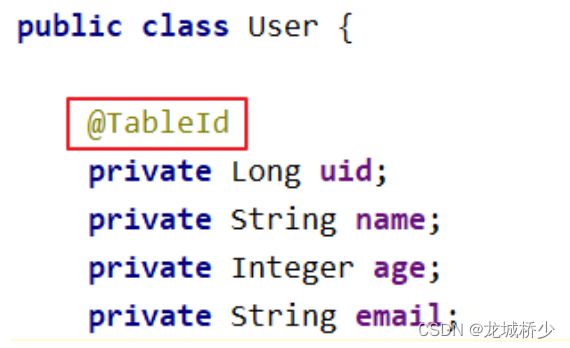MyBatis-Plus01_简介、入门案例、BaseMapper与IService中的CRUD以及常用的注解
目录
①. MyBatis-plus简介
②. MyBatis-plus入门案例
③. BaseMapper中的CRUD
④. 通用Service的CRUD
⑤. MyBatis-plus中常用注解@TableName:
⑥. 常用注解@TableId
⑦. 雪花算法
⑧常用注解@TableField
⑨. 常用注解@TableLogic——逻辑删除专用注解
①. MyBatis-plus简介
- ①. MyBatis-Plus(简称 MP)是一个 MyBatis的增强工具,在MyBatis的基础上只做增强不做改变,为简化开发、提高效率而生。MyBatis-Plus提供了通用的mapper和service,可以在不编写任何SQL语句的情况下,快速的实现对单表的CRUD、批量、逻辑删除、分页等操作。(我们的愿景是成为MyBatis最好的搭档,就像魂斗罗中的1P、2P,基友搭配,效率翻倍)
- ②. 特性
- 无侵入:只做增强不做改变,引入它不会对现有工程产生影响,如丝般顺滑
- 损耗小:启动即会自动注入基本CURD,性能基本无损耗,直接面向对象操作
- 强大的CRUD操作:内置通用Mapper、通用Service,仅仅通过少量配置即可实现单表大部分CRUD操作,更有强大的条件构造器,满足各类使用需求
- 支持Lambda形式调用:通过Lambda表达式,方便的编写各类查询条件,无需再担心字段写错
- 支持主键自动生成:支持多达4种主键策略(内含分布式唯一ID生成器-Sequence),可自由配置,完美解决主键问题
- 支持ActiveRecord模式:支持ActiveRecord形式调用,实体类只需继承Model类即可进行强大的CRUD操作
- 支持自定义全局通用操作:支持全局通用方法注入(Writeonce,useanywhere)
- 内置代码生成器:采用代码或者Maven插件可快速生成Mapper、Model、Service、Controller层代码,支持模板引擎,更有超多自定义配置等您来使用
- 内置分页插件:基于MyBatis物理分页,开发者无需关心具体操作,配置好插件之后,写分页等同于普通List查询
- 分页插件支持多种数据库:支持MySQL、MariaDB、Oracle、DB2、H2、HSQL、SQLite、Postgre、SQLServer等多种数据库
- 内置性能分析插件:可输出SQL语句以及其执行时间,建议开发测试时启用该功能,能快速揪出慢查询
- 内置全局拦截插件:提供全表delete、update操作智能分析阻断,也可自定义拦截规则,预防误操作
- ③. 支持的数据库
MySQL,Oracle,DB2,H2,HSQL,SQLite,PostgreSQL,SQLServer,Phoenix,Gauss ,ClickHouse,Sybase,OceanBase,Firebird,Cubrid,Goldilocks,csiidb
达梦数据库,虚谷数据库,人大金仓数据库,南大通用(华库)数据库,南大通用数据库,神通数据库,瀚高数据库
- ④. 框架结构
从扫描实体类开始,通过反射技术将实体类中的属性进行抽取,抽取后来分析当前表和实体类之间的关系,以及通过反射技术抽取出来的实体类中的属性与当前字段的关系,根据调用的方法,来生成相对应的SQL语句,将SQL语句注入到mybatis的容器中
- ⑤. 官方文档
②. MyBatis-plus入门案例
- ①. 创建一张user表并添加数据
DROP TABLE IF EXISTS user;
CREATE TABLE user
(
id BIGINT(20) NOT NULL COMMENT '主键ID',
name VARCHAR(30) NULL DEFAULT NULL COMMENT '姓名',
age INT(11) NULL DEFAULT NULL COMMENT '年龄',
email VARCHAR(50) NULL DEFAULT NULL COMMENT '邮箱',
PRIMARY KEY (id)
);
INSERT INTO user (id, name, age, email) VALUES
(1, 'Jone', 18, '[email protected]'),
(2, 'Jack', 20, '[email protected]'),
(3, 'Tom', 28, '[email protected]'),
(4, 'Sandy', 21, '[email protected]'),
(5, 'Billie', 24, '[email protected]');
- ②. 添加依赖
org.springframework.boot
spring-boot-starter
org.springframework.boot
spring-boot-starter-test
test
com.baomidou
mybatis-plus-boot-starter
3.5.1
mysql
mysql-connector-java
5.1.49
org.projectlombok
lombok
1.18.8
- ③. 在application.yml中配置数据源信息并添加日志以便于查看sql语句
spring:
datasource:
#数据源信息,默认就是Hikari
type: com.zaxxer.hikari.HikariDataSource
#配置连接数据库的信息
driver-class-name: com.mysql.jdbc.Driver
url: jdbc:mysql://localhost:3306/mybatis_plus?userSSL=false
username: root
password:
#mybatis-plus日志
mybatis-plus:
configuration:
log-impl: org.apache.ibatis.logging.stdout.StdOutImpl1、驱动类driver-class-name
spring boot 2.0 (内置 jdbc5 驱动),驱动类使用:driver-class-name : com.mysql.jdbc.Driverspring boot 2.1 及以上(内置 jdbc8 驱动),驱动类使用:driver-class-name: com.mysql.cj.jdbc.Driver否则运行测试用例的时候会有 WARN 信息2、连接地址urlMySQL5.7 版本的 url :jdbc:mysql://localhost:3306/mybatis_plus?characterEncoding=utf-8&useSSL=falseMySQL8.0 版本的 url :jdbc:mysql://localhost:3306/mybatis_plus?serverTimezone=GMT%2B8&characterEncoding=utf-8&useSSL=false否则运行测试用例报告如下错误:java.sql.SQLException: The server time zone value 'Öйú±ê׼ʱ¼ä' is unrecognized orrepresents more
- ④. 为启动类添加mapper包扫描
@SpringBootApplication
@MapperScan("com.songqiao.mybatisplus.mapper")
public class MybatisplusApplication {
public static void main(String[] args){
SpringApplication.run(MybatisplusApplication.class, args);
}
}- ⑤. 添加实体类与数据库字段映射(此处使用了 Lombok (opens new window) 简化代码)
@Data
@AllArgsConstructor
@NoArgsConstructor
public class User {
private Long id;
private String name;
private Integer age;
private String email;
private Integer isDeleted;
}
- ⑥. 编写mapper包下的UserMapper接口使其继承MyBatis-plus提供的模板mapper:BaseMapper
@Mapper
public interface UserMapper extends BaseMapper {
} ⑦. 添加测试类进行测试
@SpringBootTest
class MybatisPlusApplicationTests {
@Autowired
private UserMapper userMapper;
@DisplayName("查询全部")
@Test
public void testSelectList(){
//通过条件构造器查询一个list集合,无条件设置null为参数
List users = userMapper.selectList(null);
users.forEach(System.out::println);
}
} ③. BaseMapper中的CRUD
①. 新增:int insert(T entity)
最终执行的结果,所获取的id为147575498278871312,这是因为MyBatis-Plus在实现插入数据时,会默认基于雪花算法的策略生成id
@DisplayName("新增测试")
@Test
//INSERT INTO user ( id, name, age, email ) VALUES ( ?, ?, ?, ? )
public void testInsert(){
User user=new User(null,"桥哥",23,"[email protected]",null);
int i = userMapper.insert(user);
System.out.println("受影响的行数:"+i);
System.out.println("id:"+user.getId());
}②. 删除:
根据id删除:int deleteById(Serializable id);
根据map中设置的条件删除:int deleteByMap(@Param(“cm”) Map
通过多个id实现批量删除:int deleteBatchIds(@Param("cm") Collection idList);
@DisplayName("多种删除方式:id删除,条件删除、批量删除")
@Test
public void testDelete(){
//DELETE FROM user WHERE id=?
int delete = userMapper.deleteById(1659152120739282946L);
System.out.println(delete);
// DELETE FROM user WHERE name = ? AND age = ?
Map map=new HashMap<>();
map.put("name","张三");
map.put("age",23);
int byMap = userMapper.deleteByMap(map);
System.out.println(byMap);
//DELETE FROM user WHERE id IN ( ? , ? )
List numbers = Arrays.asList(8L, 9L,10L);
int batchIds = userMapper.deleteBatchIds(numbers);
System.out.println(batchIds);
} ③. 修改:int updateById(@Param("cm") T entity);
@DisplayName("修改方法")
@Test
public void testUpdate(){
//根据id修改用户信息
// UPDATE user SET name=?, email=? WHERE id=?
User user=new User();
user.setId(3L);
user.setName("龙城桥少");
user.setEmail("[email protected]");
int updateById = userMapper.updateById(user);
System.out.println(updateById);
}④. 查询:
根据id查询:T selectById(Serializable id);
根据多个id查询:List
根据map条件查询:List
查询全部:List
@DisplayName("查询的各种方式")
@Test
public void testSelect(){
//根据id查询用户信息
User user = userMapper.selectById(3L);
System.out.println(user);
//根据多个id批量查询
//SELECT id,name,age,email FROM user WHERE id IN ( ? , ? )
List longs = Arrays.asList(3L, 4L);
List list = userMapper.selectBatchIds(longs);
list.forEach(System.out::println);
//根据map条件查询
// SELECT id,name,age,email FROM user WHERE name = ?
Map map=new HashMap<>();
map.put("name","龙城桥少");
List list1 = userMapper.selectByMap(map);
System.out.println(list1);
//通过条件构造器查询一个list集合,无条件设置null为参数
//SELECT id,name,age,email,is_deleted FROM t_user
List users = userMapper.selectList(null);
users.forEach(System.out::println);
} ④. 通用Service的CRUD
- ①. 通用Service CRUD封装IService (opens new window)接口,进一步封装CRUD采用get查询单行remove删除list查询集合page分页 前缀命名方式区分Mapper层避免混淆
- ②. 泛型T为任意实体对象
- ③. 建议如果存在自定义通用Service方法的可能,请创建自己的IBaseService继承Mybatis-Plus提供的基类
- ④. 对象 Wrapper 为 条件构造器
- ⑤. 查看IService接口和ServiceImpl实现类
/**
* UserService继承IService模板提供的基础功能
*/
public interface UserService extends IService {
} /**
* ServiceImpl实现了IService,提供了IService中基础功能的实现
* 若ServiceImpl无法满足业务需求,则可以使用自定的UserService定义方法,并在实现类中实现
*/
@Service
public class UserServiceImpl extends ServiceImpl implements UserService {
} - ⑥. 查询记录条数与批量添加功能
@Autowired
UserService userService;
@DisplayName("查询记录数")
@Test
public void testGetCount(){
//SELECT COUNT( * ) FROM user WHERE (name LIKE ?)
QueryWrapper wrapper=new QueryWrapper<>();
wrapper.like("name","桥");
long count = userService.count(wrapper);
System.out.println("总记录数:"+count);
}
@DisplayName("批量添加")
@Test
public void testInsertMore(){
List list=new ArrayList<>();
for (int i = 0; i <=10 ; i++) {
User user=new User();
user.setName("wsq"+i);
user.setAge(20+i);
list.add(user);
}
boolean b = userService.saveBatch(list);
System.out.println(b);
} - ⑦. IService中的查询方法:
// 查询所有
List list();
// 查询列表
List list(Wrapper queryWrapper);
// 查询(根据ID 批量查询)
Collection listByIds(Collection idList);
//listByIds底层还是调用的this.getBaseMapper().selectBatchIds(idList);方法
// 查询(根据 columnMap 条件)
Collection listByMap(Map columnMap);
// 查询所有列表
List> listMaps();
// 查询列表
List> listMaps(Wrapper queryWrapper);
// 查询全部记录
List - ⑧. IService插入方法:
// 插入一条记录(选择字段,策略插入)
boolean save(T entity);
// 插入(批量)
boolean saveBatch(Collection entityList);
// 插入(批量)
boolean saveBatch(Collection entityList, int batchSize);
⑤. MyBatis-plus中常用注解@TableName:
- ①. 经过以上的测试,在使用MyBatis-Plus实现基本的CRUD时,我们并没有指定要操作的表,只是在 Mapper接口继承BaseMapper时,设置了泛型User,而操作的表为user表 由此得出结论,MyBatis-Plus在确定操作的表时,由BaseMapper的泛型决定,即实体类型决 定,且默认操作的表名和实体类型的类名一致。
那么,若实体类类型的类名和要操作的表的表名不一致,会出现什么问题?
我们将表user更名为t_user,测试查询功能,程序抛出异常,Table 'mybatis_plus.user' doesn't exist,因为现在的表名为t_user,而默认操作 的表名和实体类型的类名一致,即user表
- ②. 使用@TableName注解解决实体类与表名不一致问题
在实体类类型上添加@TableName("t_user"),标识实体类对应的表,即可成功执行SQL语句
- ③. 在yml文件中进行全局配置解决
mybatis-plus:
configuration:
log-impl: org.apache.ibatis.logging.stdout.StdOutImpl
#添加表名前缀
global-config:
db-config:
table-prefix: t_⑥. 常用注解@TableId
经过以上的测试,MyBatis-Plus在实现CRUD时,会默认将id作为主键列,并在插入数据时,默认 基于雪花算法的策略生成id
- ①. 问题:若实体类和表中表示主键的不是id,而是其他字段,例如uid,MyBatis-Plus会自动识别uid为主键列吗?我们实体类中的属性id改为uid,将表中的字段id也改为uid,测试添加
- ②. 使用@TableId解决:在实体类中uid属性上通过@TableId将其标识为主键,即可成功执行SQL语句
-
③. @TableId的value属性
如果数据库的字段为id,实体类中的字段为uid,那么mybatis-plus会以实体类中的属性进行查询,系统就会报错:
- ④. @TableId中的type属性 type属性用来定义主键策略
- ⑤. 使用全局配置来自定义主键策略
# 配置mybatis-plus的日志信息
mybatis-plus:
configuration:
# classpath:/mapper/**/*.xml 只扫描自己的路径下
mapper-locations:
classpath: /mapper/**/*.xml
# 配置MyBatis-Plus操作表的默认前缀
global-config:
db-config:
table-prefix: t_
# 配置MyBatis-Plus的主键自增策略
id-type: auto
⑦. 雪花算法
- ①. 背景
- 需要选择合适的方案去应对数据规模的增长,以应对逐渐增长的访问压力和数据量。
- 数据库的扩展方式主要包括:业务分库、主从复制,数据库分表
- ②. 数据库分表
将不同业务数据分散存储到不同的数据库服务器,能够支撑百万甚至千万用户规模的业务,但如果业务继续发展,同一业务的单表数据也会达到单台数据库服务器的处理瓶颈。例如,淘宝的几亿用户数据,如果全部存放在一台数据库服务器的一张表中,肯定是无法满足性能要求的,此时就需要对单表数据进行拆分。
- ③. 垂直分表
- 垂直分表适合将表中某些不常用且占了大量空间的列拆分出去
- 例如,前面示意图中的nickname和description字段,假设我们是一个婚恋网站,用户在筛选其他用户的时候,主要是用age和sex两个字段进行查询,而nickname和description两个字段主要用于展示,一般不会在业务查询中用到。description本身又比较长,因此我们可以将这两个字段独立到另外一张表中,这样在查询age和sex时,就能带来一定的性能提升
- ④. 水平分表
- 水平分表适合表行数特别大的表,有的公司要求单表行数超过5000万就必须进行分表,这个数字可以作为参考,但并不是绝对标准,关键还是要看表的访问性能。对于一些比较复杂的表,可能超过1000万就要分表了。而对于一些简单的表,即使存储数据超过1亿行,也可以不分表。
- 但不管怎样,当看到表的数据量达到千万级别时,作为架构师就要警觉起来,因为这很可能是架构的性能瓶颈或者隐患。
- 水平分表相比垂直分表,会引入更多的复杂性,例如要求全局唯一的数据id该如何处理
- ⑤. 主键自增
- 以最常见的用户ID为例,可以按照1000000 的范围大小进行分段,1 ~ 999999 放到表 1中,1000000 ~ 1999999 放到表2中,以此类推
- 复杂点:分段大小的选取。分段太小会导致切分后子表数量过多,增加维护复杂度;分段太大可能会导致单表依然存在性能问题,一般建议分段大小在100万至2000万之间,具体需要根据业务选取合适的分段大小。
- 优点:可以随着数据的增加平滑地扩充新的表。例如,现在的用户是100万,如果增加到1000万,只需要增加新的表就可以了,原有的数据不需要动。
- 缺点:分布不均匀。假如按照1000万来进行分表,有可能某个分段实际存储的数据量只有1条,而另外一个分段实际存储的数据量有1000万条。
- ⑥. 取模
- 同样以用户ID为例,假如我们一开始就规划了10个数据库表,可以简单地用user_id%10的值来表示数据所属的数据库表编号,ID为985的用户放到编号为5的子表中,ID为10086的用户放到编号为6的子表中。
- 复杂点:初始表数量的确定。表数量太多维护比较麻烦,表数量太少又可能导致单表性能存在问题。
- 优点:表分布比较均匀。
- 缺点:扩充新的表很麻烦,所有数据都要重分布。
- ⑦. 雪花算法:是由Twitter公布的分布式主键生成算法,它能够保证不同表的主键的不重复性,以及相同表的主键的有序性
- 长度共64bit(一个long型)。
- 首先是一个符号位,1bit标识,由于long基本类型在Java中是带符号的,最高位是符号位,正数是0,负数是1,所以id一般是正数,最高位是0。
- 41bit时间截(毫秒级),存储的是时间截的差值(当前时间截-开始时间截),结果约等于69.73年。
- 10bit作为机器的ID(5个bit是数据中心,5个bit的机器ID,可以部署在1024个节点)。
- 12bit作为毫秒内的流水号(意味着每个节点在每毫秒可以产生4096个ID)
- ⑧. 优点:整体上按照时间自增排序,并且整个分布式系统内不会产生ID碰撞,并且效率高。
⑧常用注解@TableField
- ①. 情况一:
- 例如实体类属性userName,表中字段user_name
- 此时MyBatis-Plus会自动将下划线命名风格转化为驼峰命名风格,相当于在MyBatis中配置
- ②. 情况二:
若实体类中的属性和表中的字段不满足情况1
- 例如实体类属性name,表中字段username
- 此时需要在实体类属性上使用@TableField("username")设置属性所对应的字段名
⑨. 常用注解@TableLogic——逻辑删除专用注解
- ①. 逻辑删除的概念:
- 物理删除:真实删除,将对应数据从数据库中删除,之后查询不到此条被删除的数据
- 逻辑删除:假删除,将对应数据中代表是否被删除字段的状态修改为“被删除状态”,之后在数据库中仍旧能看到此条数据记录
使用场景:用于数据恢复
(逻辑未删除默认是0,删除默认是1)
- ②. 应用逻辑删除:
- 数据库中创建逻辑删除状态列,设置默认值为0
2.在实体类中创建逻辑删除属性
@Data
@AllArgsConstructor
@NoArgsConstructor
public class User {
//不使用雪花算法,使用自动递增策略
@TableId(type = IdType.AUTO)
private Long id;
private String name;
private Integer age;
private String email;
//逻辑删除的注解
@TableLogic
private Integer isDeleted;
}- ③. 测试 :测试删除功能,真正执行的是修改
- ④. 总结:在MyBatis-plus中,使用@TableLogic注解后,被注解标注的实体类属性会被当做逻辑删除的字段,在执行CRUD操作时sql语句会对逻辑删除字段进行判断。
- ⑤. 对逻辑删除的默认值进行全局配置
mybatis-plus:
global-config:
db-config:
id-type: auto #选择主键自增策略
logic-delete-value: 1 # 逻辑已删除值(默认为 1)
logic-not-delete-value: 0 # 逻辑未删除值(默认为 0)
- ⑥. 在注解中自定义逻辑删除的默认值
@TableLogic(value=“原值”,delval=“修改值”)
value = “” 未删除的值,默认值为0
delval = “” 删除后的值,默认值为1
@TableLogic(value="0",delval="1")
private Integer isdelete;













